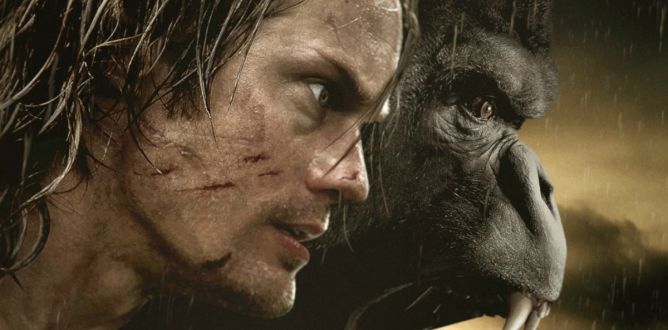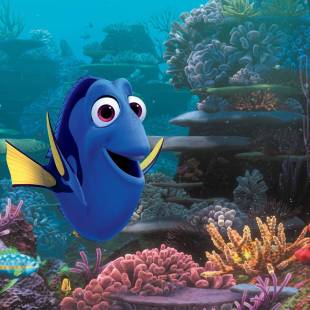The Legend of Tarzan Parent Guide
Alexander Skarsgård plays the unbelievably buff King of the Jungle – so buff I’m wondering if a few CGI dollars weren’t spent chiseling his six-pack.
Parent Movie Review
Put late twentieth century history into a blender, add an abdominizer, and you might end up with something similar to the Legend of Tarzan. Alexander Skarsgård plays the unbelievably buff King of the Jungle – so buff I’m wondering if a few CGI dollars weren’t spent chiseling his six-pack. Producing a noticeable gasp from the females in my screening audience after removing his shirt, this vine swinger seems poised to keep romance and action seeking movies goers happy. And that brings me to Jane (Margot Robbie), the eye candy for the men, whose blonde ambition extends to swimming with the crocodiles and coming to shore with her dress still looking better than my shirt after a short haul flight.
The story is set in the Belgian Congo, when the unseen, off-shore ruler King Leopoldo II, is drowning in debt. He sends his right hand man Leon Rom (Christoph Waltz) to work a deal with the chief of the Mobolonga (Djimon Hounsou). Looking like a hit man on an African Safari, the white suited thug promises to catch and deliver Tarzan to the indigenous group in exchange for access to a lucrative stash of diamonds found on the tribal lands. Of course if you wish to catch something a little bait is helpful. So Rom kidnaps Jane, convinced her husband will come running. And he does.
In case this setup sounds to serious, the screenwriters offer comic relief in the form of Samuel L. Jackson playing an American humanitarian sent along for the ride to investigate if the Belgians are capturing African slaves (yes they are) and to act as a jungle neophyte next to our hero.
Parents who have fond memories of Tarzan in animated form should flush that Phil Collins’ song and dance show from their minds. This retelling is far more intense and, despite Jackson’s witticisms, deals with subtopics of genocide, racial prejudice, animal harvesting and the aforementioned slavery. With this much conflict it’s no surprise the resulting violence is frequent and likely to be disturbing to young viewers. Animals and humans are mowed down with guns, spears and arrows. Tarzan has the ability to take on a legion of attackers with his bare arms, tossing them hither and yon.
We also have our damsel in distress. While she’s eager to offer verbal blows, she is nonetheless at the mercy of various men, the most notable being Rom. He implies he would like more from her than just a lure for his prize. This, along with a brief and non-detailed sexual interlude between a husband and wife, and a handful of other crude comments, are the extent of the movie’s sexual content. A few mild and scatological profanities are included as well.
Visually compelling and directed with a keen technique for telling the present day story intercut with Tarzan’s backstory, The Legend of Tarzan is a reasonably solid concoction that blends romance and action with a dash of history.
Directed by David Yates. Starring Margot Robbie, Alexander Skarsgård, Samuel L. Jackson. Running time: 110 minutes. Theatrical release July 1, 2016. Updated July 17, 2017
The Legend of Tarzan
Rating & Content Info
Why is The Legend of Tarzan rated PG-13? The Legend of Tarzan is rated PG-13 by the MPAA for sequences of action and violence, some sensuality and brief rude dialogue.
Violence: Many scenes depict humans and animals in perilous situations. Conflicts involve various weapons including guns, spears, arrows, knives and hand-to-hand combat, however little blood or detail is seen. A group of soldiers indiscriminately shoot at indigenous people whom we later see lying dead on the ground. A character specializes in choking others—we see this occur on various occasions. A man is brutally beaten by a large ape. A man enters a moving rail car full of soldiers and begins killing, throwing and injuring them. A key character is shot off-screen, a secondary character’s ear is shot off on-screen—we see a very brief view of the injury. A woman is captured, threatened and detained in handcuffs; at one point her male captor vaguely implies he would like sexual favors from her. A huge herd of animals stampedes through a community, knocking down people and buildings—we see one a secondary character being trampled. A man is assumed to eaten by a crocodile (unseen on screen). In the opening moments of the film an ill mother dies, a father is beaten to death by apes, and an infant is captured by the animals and raised as their own—this sequence may be particularly frightening for young children. Indigenous African people are rounded up and put on vessels and trains for the purpose of being sold as slaves.
Sexual Content: A character suggests another character perform a sexual act on an animal. A man holding a woman hostage implies she should provide sexual favors (she doesn’t). A married couple are briefly seen having sex—we see non-explicit views of them embracing. A sexual remark is made regarding a Catholic priest. Some people are seen in clothing that reveals their buttocks and male chests.
Language: The script includes a single scatological slang along with infrequent mild profanities, a crude term for male anatomy and a Christian deity used as an expletive.
Alcohol / Drug Use: Alcohol use is depicted within a social situation.
Page last updated July 17, 2017
The Legend of Tarzan Parents' Guide
King Leopoldo II of Belgian isn’t just unseen in this movie. His brutal rule over the Congo attracted international criticism even at the turn of the 20th century, yet he never visited his privately owned “country”. Enslaving much of the population to work to produce rubber and extract minerals for his benefit, the Belgian government finally took responsibility in an effort to protect the king from further criticism. While this dark period is referenced in this movie, you can learn more about this history.
“Pulp fiction” is not just the name of a 1994 cult movie. It’s a term given to a type of “cheap” literature published in the early 20th Century. It is within this genre that Tarzan got his original roots. Read more about the history of Tarzan. Discover more about Edgar Rice Burroughs and his novels about Tarzan.
News About "The Legend of Tarzan"
This movie is inspired by the Edgar Rice Burroughs' novels about Tarzan.
Home Video
The most recent home video release of The Legend of Tarzan movie is October 11, 2016. Here are some details…
Home Video Notes: The Legend of Tarzan
Release Date: 11 October 2016
The Legend of Tarzan releases to home video (Blu-ray + DVD + Digital HD UltraViolet Combo Pack, DVD Special Edition or Blu-ray: 4K Ultra HD + Blu-ray) with the following special features:
- Tarzan Reborn
- Battles and Bare Knuckle Brawls: Train Ambush
- Battles and Bare-Knuckle Brawls: Tarzan vs. Akut
- Battles and Bare Knuckle Brawls: Boma Stampede
- Tarzan and Jane’s Unfailing Love
- Creating the Virtual Jungle
- Gabon to the Big Screen
- Stop Ivory
Related home video titles:
Disney created an animated version of Tarzan. Another youngster is raised in the wild in The Jungle Book (2016).


